12,896 hours is the average time each person spends tidying their homes during their lifetime. That’s 1,5 years or 77 weeks. These numbers hardly coincide with modern reality.
Business people, working moms, single-parent households, elderly people, and anyone else who can afford it, often delegate home cleaning to professionals and use the extra time for stuff they want to do.
With the growing trend of ordering services on demand, no wonder software for the house-cleaning business has already disrupted the gig economy. Due to the increase in self-employment and freelance work, the demand for digital platforms for maids will keep on growing in the years ahead.
How to make an app for cleaning services? Read our complete guide!
Why Create an Uber for Maids?
What do we already know about on-demand cleaning services? Here are some curious facts and stats:
- More than 3 million people work in the cleaning industry in the United States alone.
- The total revenue of the home services market was estimated at more than $280 billion in 2018 and it is expected to reach up to $1,200 billion by 2026.
- 23 out of 310 unicorn startups (companies valued at $1 billion) in 2019 were in the on-demand gig economy.
- According to Harvard Business Review, more than 22.4 million consumers use on-demand services annually and this number is growing constantly.
- The portrait of the average consumer of on-demand cleaning services looks like this: millennials (aged 30 to 54), male or female, 4-year degree or more, couples with kids working full-time, or single professionals, living in the suburbs and earning $50,000 or more, annually.
- Most requests for cleaning services come from the commercial (55%), followed by industrial (30%) and residential (15%) sectors.
4 Things You Need to Know Before Creating a Cleaning App
Cleaning app development should be preceded by proper market research. What things should you include in your preparation plan?
1. Start with on-demand home service market research
Collect and analyze as much data as possible. Their questions can help you get started:
- Is there a demand for cleaning services in your area?
- Who is your target audience?
- Are there similar solutions in the market?
- Do they thoroughly satisfy customer needs?
- How to monetize this business?
- What are the challenges of the niche?
- What unique features or user workflow can you bring to users?
2. Perform a competitive analysis among top players
The US, UK, and Singapore are major consumers of cleaning services. Other countries are following their example and integrating their ideas into their lifestyle.
Today, we can define two main types of marketplaces for on-demand cleaning services:
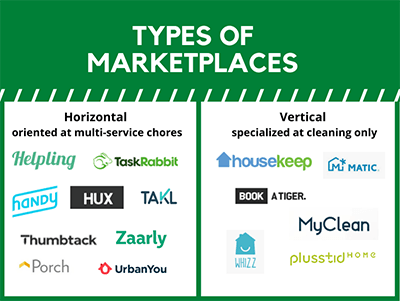
As a rule, new marketplaces tend to start with the vertical marketplace (create apps for house cleaning) and then extend horizontally adding new services. Find out what your local market is lacking and search for opportunities in more specific narrow areas like commercial or industrial cleaning, equipment cleaning, gardening, after-party cleaning, washing windows, doing laundry, etc.
3. Choose a revenue model for your app
The next thing you need to decide before home cleaning app-building is how you are going to monetize your app.
The cleaning service marketplace connects customers with service providers and regulates the relationships between them.
There are several ways you can get profit from a maid service online marketplace:
- Registration fee. Take some fee for the registration of new service providers to prove their seriousness. Do not just take money, but provide some value in exchange. For example, the Hux platform charges $17 on registration for a background check that will generate consumer trust.
- Freemium. This is a subscription with partially free access to the platform. It allows users to register and use the core platform functionality without charge. But if they need advanced features, they will have to pay to upgrade their accounts. For example, Porch provides an upgrade with membership in the Vetted Pros Program for $359.99 per year.
- Transaction fee. The online marketplace may charge fees for each transaction. These are either fixed-price or a percentage of each payment through the platform. The fee may be taken either from the clients (Handy — $3) or from the home service providers (TaskRabbit — 15%).
- Lead fees. The fee is taken from the cleaning service’s pre-paid deposit for each lead whether the service was booked or not. Thumbtack charges 20% for each lead when the service provider initiates a conversation with them.
- Featured listings and ads. Some platforms do not charge for leads, sign-ups or transactions, but push their users to buy extra services. They might charge for the top position in the search results, customization of their profile, showing up in featured listings or banner ads.
You may choose one of their methods or combine several.
4. Get prepared for the challenges
There are certain challenges you may face when entering the market. But before creating your own cleaning services platform, you can be prepared for some of them.
Challenge 1: Creating a trustworthy service
A home is a sacred place for people and trust means everything there. You cannot guarantee that service companies registered in the marketplace or their employees will behave in a proper way and provide quality service. So get ready for complaints, conflicts, and even lawsuits.
Solution: Maintaining a good reputation is the key to the success of an on-demand services network. To prevent problems, platforms use such practices as ID and background screening, skills verification, and obligatory professional training and certification. They also demand paid registration, and they charge fines for lateness and no-shows. Let the customers see the bio and photo of the cleaners when they book so that they feel safer about letting a stranger in their house.
Challenge 2: Regulating relationships with contractors
A lot of issues come up because of a misunderstanding between the platform and contractors.
One of the most famous cases involved Homejoy, one of the fastest-growing Y Combinator companies in the on-demand cleaning services market. They raised $40 million in funding and quickly expanded throughout most of the US, Canada, and Europe, but in a few short years, they announced their closure. One of the reasons for their failure was multiple lawsuits with contractors who claimed they were the platform’s employees and demanded all corresponding conditions like salary, insurance, tax payments, and leaves.
Solution: Here are some recommendations you can implement:
- Explain in detail to the contractors their rights, and obligations. Have them sign the Terms and Conditions.
- Set fair rates for services and make payment processes transparent, timely, and easy.
- Think about how the platform will regulate taxes — if the platform will pay the taxes for their contractors or contractors will pay by themselves. In the first case, you should inform the service providers that taxes will be withheld from their pay; this will demand a sophisticated accounting system. In the second case, you will need the contractors to sign a confirmation that they will pay the tax themselves. In addition, you must take into account the local peculiarities of tax laws.
- It’s usually a good idea to take care of insurance for cleaners in case some customers' belongings are damaged.
Challenge 3: Pros leakage
Striving for the best quality service for their customers, the platforms take the cleaners through testing, training, and background checks. Good quality of services helps strengthen the platform’s reputation, increases customer loyalty, and allows you to increase prices. However, once you have found a good contractor and trained her, the risks of professional leakage grow. Homeowners who like a certain cleaner often try to hire them directly.
Solution:
It is really hard to combat this problem, as good specialists are always searching for better conditions. You can only try to keep the salaries competitive as well as involve customers in loyalty programs for recurring orders.
Challenge 4: Tough competition on the market
Online cleaning service marketplaces have to compete not only with similar platforms but also with independent companies. The market size is huge but experienced competitors with a larger database of clients and cleaners will not let the newbies ahead.
Solution: To become a new but strong player, you will have to win over potential clients by providing better service and security, trendy features, and a modern and unique approach to solving issues.
Need an estimate of your cleaning services marketplace?
Contact UsWhat Features Should be Included in Your App for Cleaning Services?
On-demand cleaning service marketplaces are two-fold platforms that play the role of a mediator connecting customers with cleaners.
That’s why to build an app for house cleaning, we need to differentiate the features of the Customer, Service Provider, and Admin. At the same time, all three sections should synchronize data and respond to actions performed by each other.
Let’s describe in more detail what features each section should have.
Customer Section:
This is a customer directory where they can log in and order on-demand cleaning services.
- Sign up/in
Nowadays, websites postpone registration until the user reaches the Payment step. You should make the registration process simple and quick, adding the possibility of a single-sign-on (SSO) through social media or a Google account.
Some platforms use registration as a part of the anti-spam procedure. They may ask for a zip code, address, and phone number for verification. This is a common practice for marketplaces that work on the Lead Fee revenue model to filter real leads from fake.
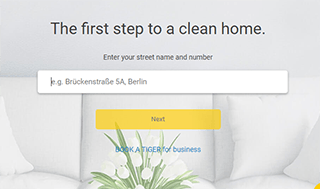
- User profile
Take the data entered at registration, from social media, or the first booking to create a User Profile. The user should be able to edit the profile, add a photo, choose Preferences, and change the settings. Go minimalist! For example, the Whizz account consists only of bookings and nothing more. The less personal data collected, the better for user security.
- Search for service and matching
Depending on the business model, the search can be implemented in different ways. Users might search by keywords and they will see all matching providers. They can write to them directly.
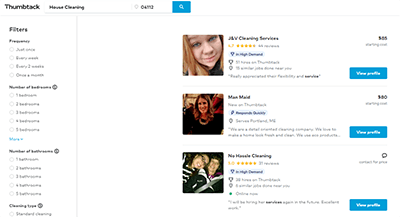
Another way is to collect the customer’s preferences with a questionnaire and send the information to contractors so that they can provide quotes.
We implemented a precise matching feature in NoCowboys on-demand tradesmen marketplace for our client from New Zealand. The search scans the listings by such parameters as a category, service location, proximity to property, rating, and the age of the last review.
- Cleaners Profile View
This is where customers can view information on each service provider. Profile details may include a logo of the company, a photo of a cleaner, address, skills certification, services offered, description, ratings, and reviews.
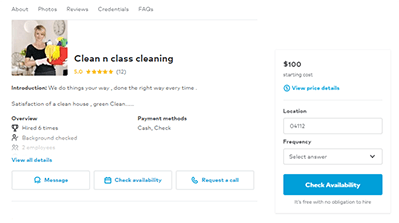
- Quote calculation
Some platforms set fixed prices for services; others estimate individually ‒ allowing customers to select necessary parameters and get an automatically calculated quote. As all facilities are different, the more precise the request, the more accurate the quote is. Add an option to clarify the details of accommodation (types of rooms, number of windows, carpets, kitchen equipment). This will help cleaners prepare for the work, and estimate the time demanded by the job in order to prevent overtime.
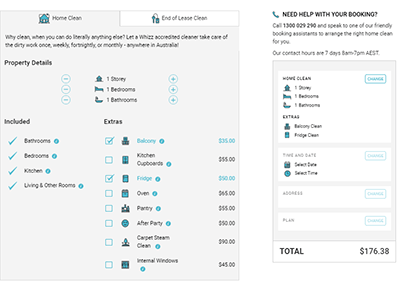
- Time recommendation system
One of the challenges many platforms bump into is overtimes and overlaps that happen when customers underestimate the volume of the tasks. Clients are known for doing this because they are always trying to get away with less money. An AI-based recommendation system can help calculate time and price based on previous orders.
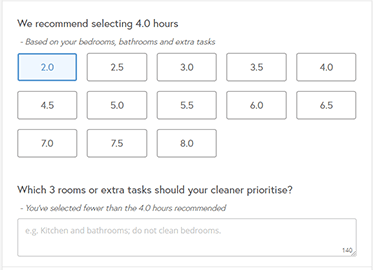
- Availability and scheduling
The availability option allows services to set their working hours and reduce the hassle connected with scheduling and double bookings. Many platforms allow the clients to select the frequency of services — one time, weekly, biweekly, and so on.
- Manage bookings
Customers should be able to view, edit, and cancel bookings in their profiles.
- Messaging
Sometimes customers may need to clarify details on their order; this is easier to do in a live chat. At the same time, the platform should not allow customers and businesses to contact each other directly ensuring that all transactions are performed through the platform. To do this, you may need to prohibit some keywords that will prevent typing phone numbers, addresses, or prices.
- Payments
Usually, online marketplaces use escrow to protect both customers and service providers from fraud. With escrow, the platform holds the customer’s money until the customer confirms that the job is completed to their satisfaction. Only then is the money transferred to the provider’s account, minus the platform’s commission.
At the beginning of a house cleaning apps' development, it will be enough to integrate only one payment gateway (like Stripe). After some success, other payment options can be added.
- Reviews
Reviews are an indispensable feature for your marketplace as they powerfully influence customers' trust. People are more likely to book services from those who have high ratings and a lot of positive reviews. They hesitate to trust a service with no reviews.
The task of the technical team is to moderate reviews and to forbid offensive messages, spam, or dishonest comments.
There are many ways to filter reviews. For example, at NoCowboys, we created a verification algorithm that identifies and flags reviews from spam emails and suspicious IP addresses. The system also identifies authenticated and unauthenticated reviews.
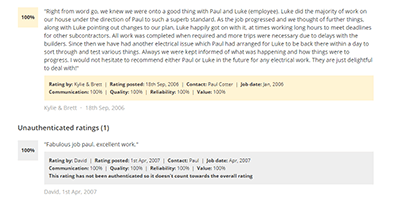
- Push notifications
Push notifications are a revenue and loyalty booster. They alert users of promotions, deals, and news in real-time to provoke action from existing customers.
Service Provider Section
In this section, businesses that provide cleaning services can manage their profiles, orders, and payments.
- Sign up/in and verification
The service provider’s registration process is complicated because it requires user verification. Cleaners may be asked to upload such items as copies of their ID, photo, and VAT identification number. The platform may perform criminal background checks systems.
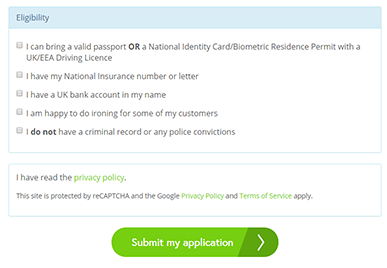
- Profile
This is where cleaners describe their services and introduce themselves to customers. Some platforms allow them to customize standard profiles in order to make them look more professional and unique.
- Order management
Businesses, as well as customers, should be able to view and edit their bookings.
- Managing finances
Keeping finances in order is important for any business. The system should track and keep a history of all transactions.
- Dashboard and reports
The dashboard allows users to have current statistics at their fingertips to estimate the effectiveness of their efforts. Reports allow users to control their performance on different metrics during a certain time period.
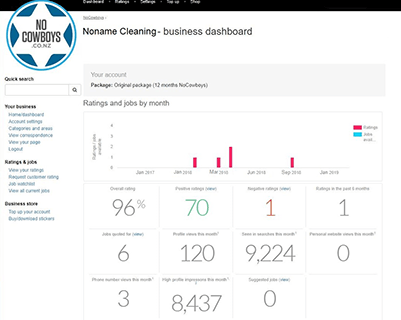
- Progress tracking when you are away
This is a nice add-on that allows customers to track the time of work and to keep an eye on the progress of contractors while they are away from home. Wouldn’t it be nice to know when the cleaning is finished so you can come back to a tidy apartment?
Admin section
The Admin is a user who manages the processes and interactions at the platform. They help customers resolve issues and track the activities of other users.
- Login
Admin needs to have secure access to the system.
- User management
Admins should be able to view and edit users, mark and blacklist spammers, and change the roles and rights of users. Admin may need the ability to login into users’ accounts to help them edit their profiles and fix problems.
- Customer Relationships System (CRM)
As a platform owner, you need to track all new customers and service providers, see the opportunities for the next sales steps, analyze the sales funnels, and the effectiveness of marketing campaigns.
- Content management system (CMS)
This is where ads, banners, blog articles, and notifications are uploaded, edited, and made visible to users.
- Service fees management
This is a page for managing fees for subscriptions and transactions. Users should be notified when their subscription is about to expire, so they can extend or change their membership plan or set up automatic renewal.
- Support desk
This is an indispensable feature for providing help to users. There is no need to develop it from zero as there are many ready-to-use support services that can be integrated through API to your website.
- Reports
Admin should have all kinds of reports connected to user activities, statistics, finances, and system performance.
Steps in House Cleaning Software Development
Now let’s come to the technical aspects of house cleaning software development. Here are some steps that you can follow to build a house cleaning app:
1. Collect the requirements and prioritize features
Hopefully, you already have our list of possible features and need only pick out what fits your project, adjusting them to your unique business idea.
2. Order Design
Design always precedes coding. Let it be simple, minimal, and contemporary. Users need to find the necessary information quickly. User-friendly design allows for intuitive user flow. You may either use a freelance designer or we can recommend our designer.
3. Find a dev team and estimate the project
The IT market is flooded with development companies, so it can take time to choose your team. Ask for quotes from several agencies, talk with their representatives to understand how you like them, and ask a lot of questions. Leave nothing to chance. With many of our clients, we start working on requirements and wireframes — helping them get prepared. During this time, we prove to the client that we are competent and trustworthy. We make the first steps toward a long-term partnership.
4. Create an MVP and test it in the market
The goal of a startup is to launch as quickly as possible with minimal investment in development. This allows you to verify your idea and get early feedback to modify the application in the next iterations. After you have prioritized a list of must-have features, you can get started on the development immediately. This is what is called a Minimum Viable Product (MVP). Our team leads and project managers can help you with the prioritization and planning of each iteration. So, do not hesitate to consult us!
5. Enhance software in the next iterations.
When your MVP passes the first approval of customers, continue improving it by adding new features and enhancing the existing ones. Continue collecting feedback and make necessary changes.
How Much Can House Cleaning Apps Cost?
Because the features and business logic of projects vary, it is impossible to give precise estimates without analyzing the exact requirements.
But let’s assume that you are going to start an on-demand cleaning app development with the following set of core features.
Customer and Service Provider sections:
- Registration and login
- User profile
- Search
- Booking management
- Payments
- Reviews
- Messaging
- Notifications
Admin section:
- Login
- Service fees management
- CMS
- CRM
- Notifications
- Support Desk
- 3-5 Reports
The development costs for an on-demand cleaning services app can vary based on the selected development strategy.
- White-label solutions, utilizing pre-existing scripts, offer prices from $5,000 to $15,000 depending on customization and added features.
- Custom development starts from $10,000 for a minimum viable product (MVP) at Greenice. Costs can increase based on the complexity of features and the hourly rates of the development team.
Entrepreneurs should carefully weigh cost, quality, and functionality to select a development path that fits their budget and business goals.
A housecleaning on-demand app development and web design of this functionality can take 5-8 months and cost between $53,000 and $86,000. This is an approximate estimate as the development time and cost may vary depending on the complexity of the features.
Cleaning App Development with Greenice
We will be glad to help you at any step of your journey — from coming up with a list of requirements to the project launch. All you need to do is contact us and describe your idea. If you have a list of features or specifications — great! It will help us estimate your project more quickly and accurately.
We have great experience in the development of online marketplaces and complex management systems. One of the projects that we are proud of is NoCowboys, a horizontal marketplace that provides the cleaning and other home repair services. The platform has a complex search and matching mechanism that takes into account multiple parameters to produce the most relevant results. It also has a system for reviews, a sophisticated verification mechanism, an anti-fraud instrument, and it collects a vast array of reports.
Here is what NoCowboys founder and CEO says about our partnership:

How to get an estimate of your cleaning services marketplace?
Contact UsRate this article!
5





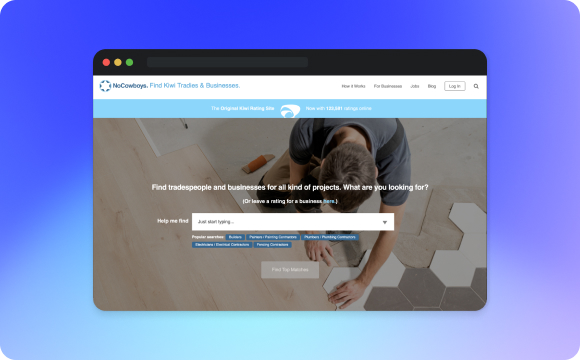



 Sign in with Google
Sign in with Google
Comments (0)